service indicator BUICK RAINIER 2006 User Guide
[x] Cancel search | Manufacturer: BUICK, Model Year: 2006, Model line: RAINIER, Model: BUICK RAINIER 2006Pages: 470, PDF Size: 2.72 MB
Page 264 of 470
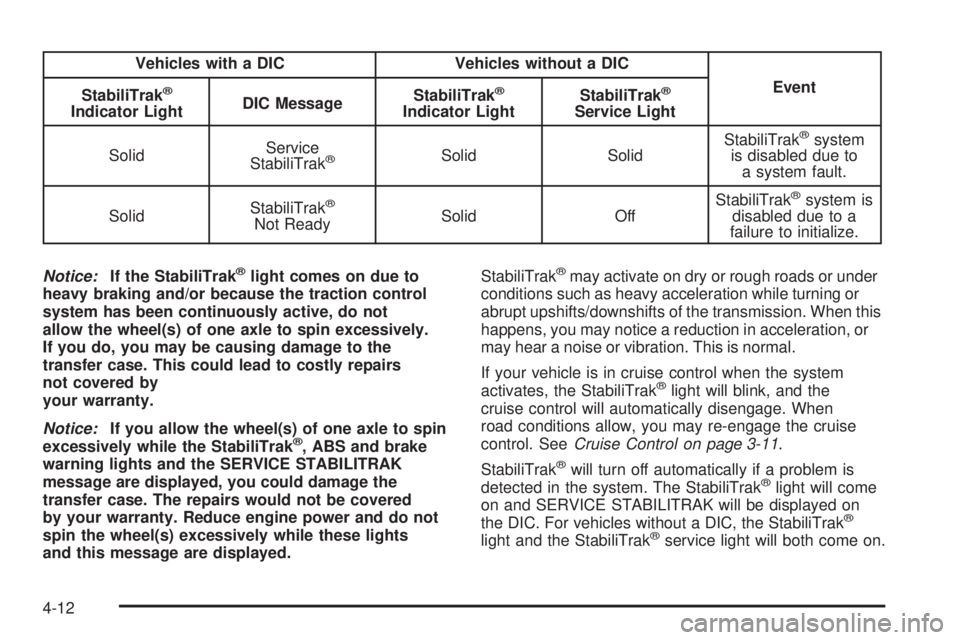
Vehicles with a DIC Vehicles without a DIC
Event
StabiliTrak
®
Indicator LightDIC MessageStabiliTrak
®
Indicator LightStabiliTrak
®
Service Light
SolidService
StabiliTrak
®Solid SolidStabiliTrak
®system
is disabled due to
a system fault.
SolidStabiliTrak
®
Not ReadySolid OffStabiliTrak
®system is
disabled due to a
failure to initialize.
Notice:If the StabiliTrak
®light comes on due to
heavy braking and/or because the traction control
system has been continuously active, do not
allow the wheel(s) of one axle to spin excessively.
If you do, you may be causing damage to the
transfer case. This could lead to costly repairs
not covered by
your warranty.
Notice:If you allow the wheel(s) of one axle to spin
excessively while the StabiliTrak
®, ABS and brake
warning lights and the SERVICE STABILITRAK
message are displayed, you could damage the
transfer case. The repairs would not be covered
by your warranty. Reduce engine power and do not
spin the wheel(s) excessively while these lights
and this message are displayed.StabiliTrak
®may activate on dry or rough roads or under
conditions such as heavy acceleration while turning or
abrupt upshifts/downshifts of the transmission. When this
happens, you may notice a reduction in acceleration, or
may hear a noise or vibration. This is normal.
If your vehicle is in cruise control when the system
activates, the StabiliTrak
®light will blink, and the
cruise control will automatically disengage. When
road conditions allow, you may re-engage the cruise
control. SeeCruise Control on page 3-11.
StabiliTrak
®will turn off automatically if a problem is
detected in the system. The StabiliTrak®light will come
on and SERVICE STABILITRAK will be displayed on
the DIC. For vehicles without a DIC, the StabiliTrak
®
light and the StabiliTrak®service light will both come on.
4-12
Page 302 of 470

Towing
Towing Your Vehicle
Consult your dealer or a professional towing service
if you need to have your disabled vehicle towed.
SeeRoadside Assistance Program on page 7-6.
If you want to tow your vehicle behind another vehicle
for recreational purposes (such as behind a motorhome),
see “Recreational Vehicle Towing” following.
Recreational Vehicle Towing
Recreational vehicle towing means towing your vehicle
behind another vehicle — such as behind a motorhome.
The two most common types of recreational vehicle
towing are known as “dinghy towing” (towing your
vehicle with all four wheels on the ground) and
“dolly towing” (towing your vehicle with two wheels
on the ground and two wheels up on a device known
as a “dolly”).Your vehicle was not designed to be towed with any
of its wheels on the ground. If your vehicle must
be towed, see “Towing Your Vehicle” earlier in
this section.
Notice:Towing an all-wheel-drive vehicle with all
four wheels on the ground, or even with only two of
its wheels on the ground, will damage drivetrain
components. Do not tow an all-wheel-drive vehicle
if any of its wheels will be on the ground.
Electronically Controlled Air
Suspension System
Your vehicle is equipped with an electronically controlled
air suspension system that automatically keeps your
vehicle level as you load and unload. The system
includes a compressor, two height sensors, and two air
springs supporting the rear axle.
The system also has an internal clock to prevent
overheating. If the system overheats, all leveling function
stops until the system cools down. During this time,
the indicator light on the air in�ator system will be
�ashing.
4-50
Page 303 of 470

The ignition has to be on for the system to in�ate, in
order to raise the vehicle to the standard ride height after
loading. The system can lower the vehicle to the
standard ride height after unloading with the ignition on
and also for up to 30 minutes after the ignition has
been turned off.
You may hear the compressor operating when you load
your vehicle, and periodically as the system adjusts
the vehicle to the standard ride height.
Load leveling will not function normally with the
in�ator hose attached to the in�ator outlet. Remove
the in�ator hose from the outlet during loading and
unloading.
If the vehicle is parked for an extended period of time,
some bleed down of the suspension is normal. Upon
starting the vehicle, proper height will be achieved.
Overload Protection
The air suspension system is equipped with overload
protection. Overload protection is designed to protect
the air suspension system, and it is an indicator to
the driver that the vehicle is overloaded. When
the overload protection mode is on, it will not allow
damage to the air compressor. However, do not
overload the vehicle. SeeLoading Your Vehicle
on page 4-45.If the suspension remains at a low height, the rear
axle load has exceeded GAWR (Gross Axle Weight
Rating). When the overload protection mode is activated,
the compressor operates for about 30 seconds to
one minute without raising the vehicle depending on
the amount of overload. This will continue each time the
ignition is turned on until the rear axle load is reduced
below GAWR.
Indicator Light
The indicator light on the in�ator switch in the rear
passenger compartment also serves as an indicator for
internal system error. If the indicator light is �ashing
without the load leveling function or the in�ator being
active, turn off the ignition. The next day turn on
the ignition and check the indicator light. The vehicle
can be driven with the light �ashing, but if it is you
should have the vehicle serviced as soon as possible.
4-51
Page 323 of 470
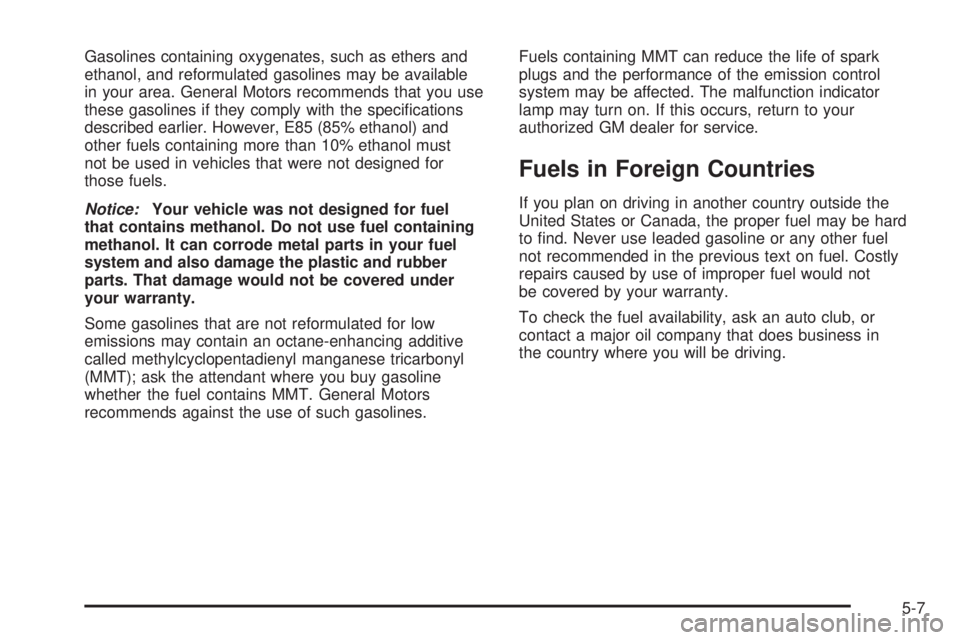
Gasolines containing oxygenates, such as ethers and
ethanol, and reformulated gasolines may be available
in your area. General Motors recommends that you use
these gasolines if they comply with the speci�cations
described earlier. However, E85 (85% ethanol) and
other fuels containing more than 10% ethanol must
not be used in vehicles that were not designed for
those fuels.
Notice:Your vehicle was not designed for fuel
that contains methanol. Do not use fuel containing
methanol. It can corrode metal parts in your fuel
system and also damage the plastic and rubber
parts. That damage would not be covered under
your warranty.
Some gasolines that are not reformulated for low
emissions may contain an octane-enhancing additive
called methylcyclopentadienyl manganese tricarbonyl
(MMT); ask the attendant where you buy gasoline
whether the fuel contains MMT. General Motors
recommends against the use of such gasolines.Fuels containing MMT can reduce the life of spark
plugs and the performance of the emission control
system may be affected. The malfunction indicator
lamp may turn on. If this occurs, return to your
authorized GM dealer for service.
Fuels in Foreign Countries
If you plan on driving in another country outside the
United States or Canada, the proper fuel may be hard
to �nd. Never use leaded gasoline or any other fuel
not recommended in the previous text on fuel. Costly
repairs caused by use of improper fuel would not
be covered by your warranty.
To check the fuel availability, ask an auto club, or
contact a major oil company that does business in
the country where you will be driving.
5-7
Page 354 of 470
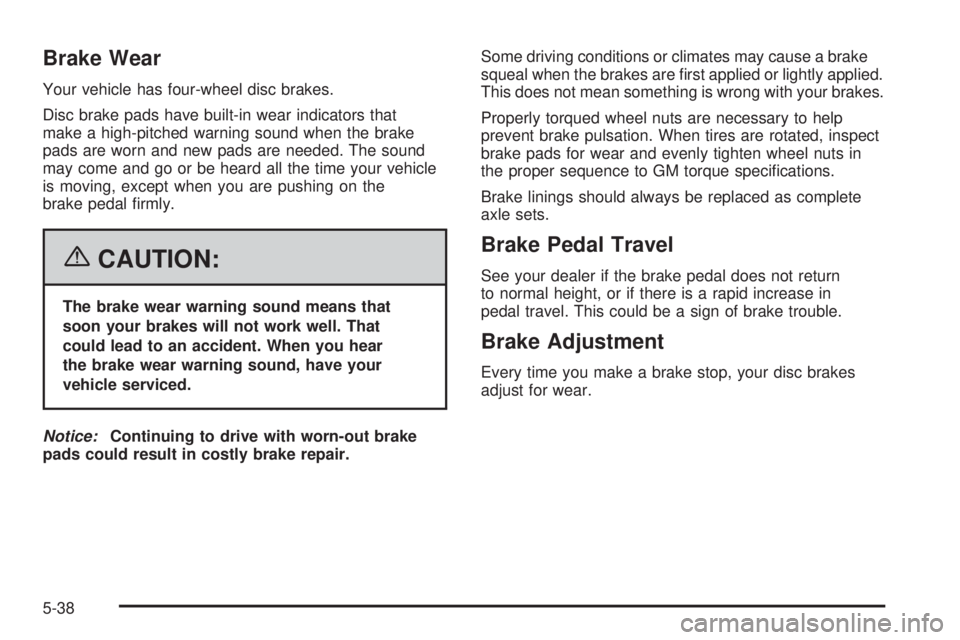
Brake Wear
Your vehicle has four-wheel disc brakes.
Disc brake pads have built-in wear indicators that
make a high-pitched warning sound when the brake
pads are worn and new pads are needed. The sound
may come and go or be heard all the time your vehicle
is moving, except when you are pushing on the
brake pedal �rmly.
{CAUTION:
The brake wear warning sound means that
soon your brakes will not work well. That
could lead to an accident. When you hear
the brake wear warning sound, have your
vehicle serviced.
Notice:Continuing to drive with worn-out brake
pads could result in costly brake repair.Some driving conditions or climates may cause a brake
squeal when the brakes are �rst applied or lightly applied.
This does not mean something is wrong with your brakes.
Properly torqued wheel nuts are necessary to help
prevent brake pulsation. When tires are rotated, inspect
brake pads for wear and evenly tighten wheel nuts in
the proper sequence to GM torque speci�cations.
Brake linings should always be replaced as complete
axle sets.
Brake Pedal Travel
See your dealer if the brake pedal does not return
to normal height, or if there is a rapid increase in
pedal travel. This could be a sign of brake trouble.
Brake Adjustment
Every time you make a brake stop, your disc brakes
adjust for wear.
5-38
Page 457 of 470
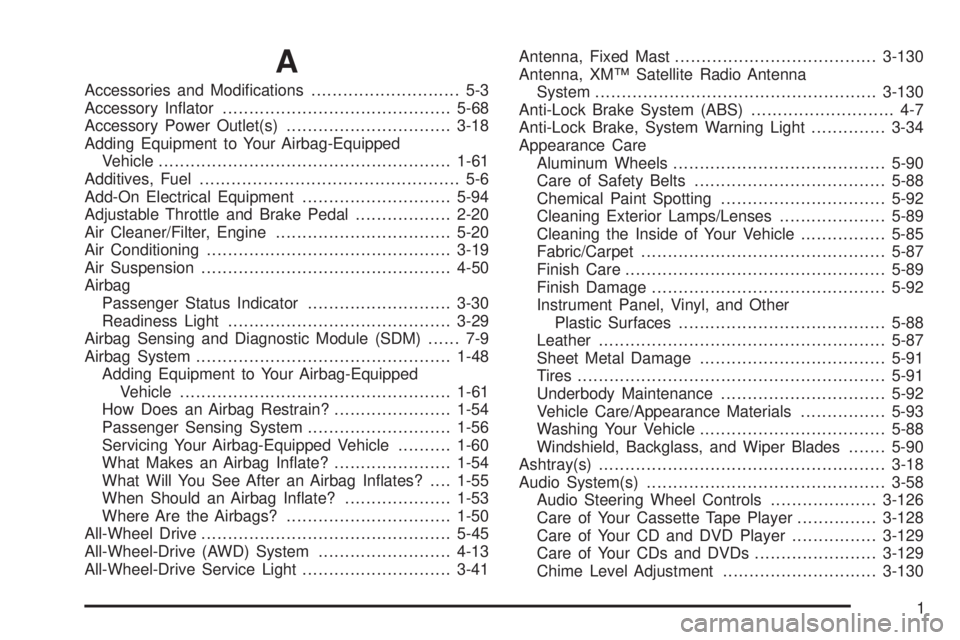
A
Accessories and Modi�cations............................ 5-3
Accessory In�ator...........................................5-68
Accessory Power Outlet(s)...............................3-18
Adding Equipment to Your Airbag-Equipped
Vehicle.......................................................1-61
Additives, Fuel................................................. 5-6
Add-On Electrical Equipment............................5-94
Adjustable Throttle and Brake Pedal..................2-20
Air Cleaner/Filter, Engine.................................5-20
Air Conditioning..............................................3-19
Air Suspension...............................................4-50
Airbag
Passenger Status Indicator...........................3-30
Readiness Light..........................................3-29
Airbag Sensing and Diagnostic Module (SDM)...... 7-9
Airbag System................................................1-48
Adding Equipment to Your Airbag-Equipped
Vehicle...................................................1-61
How Does an Airbag Restrain?......................1-54
Passenger Sensing System...........................1-56
Servicing Your Airbag-Equipped Vehicle..........1-60
What Makes an Airbag In�ate?......................1-54
What Will You See After an Airbag In�ates?....1-55
When Should an Airbag In�ate?....................1-53
Where Are the Airbags?...............................1-50
All-Wheel Drive...............................................5-45
All-Wheel-Drive (AWD) System.........................4-13
All-Wheel-Drive Service Light............................3-41Antenna, Fixed Mast......................................3-130
Antenna, XM™ Satellite Radio Antenna
System.....................................................3-130
Anti-Lock Brake System (ABS)........................... 4-7
Anti-Lock Brake, System Warning Light..............3-34
Appearance Care
Aluminum Wheels........................................5-90
Care of Safety Belts....................................5-88
Chemical Paint Spotting...............................5-92
Cleaning Exterior Lamps/Lenses....................5-89
Cleaning the Inside of Your Vehicle................5-85
Fabric/Carpet..............................................5-87
Finish Care.................................................5-89
Finish Damage............................................5-92
Instrument Panel, Vinyl, and Other
Plastic Surfaces.......................................5-88
Leather......................................................5-87
Sheet Metal Damage...................................5-91
Tires..........................................................5-91
Underbody Maintenance...............................5-92
Vehicle Care/Appearance Materials................5-93
Washing Your Vehicle...................................5-88
Windshield, Backglass, and Wiper Blades.......5-90
Ashtray(s)......................................................3-18
Audio System(s).............................................3-58
Audio Steering Wheel Controls....................3-126
Care of Your Cassette Tape Player...............3-128
Care of Your CD and DVD Player................3-129
Care of Your CDs and DVDs.......................3-129
Chime Level Adjustment.............................3-130
1
Page 463 of 470
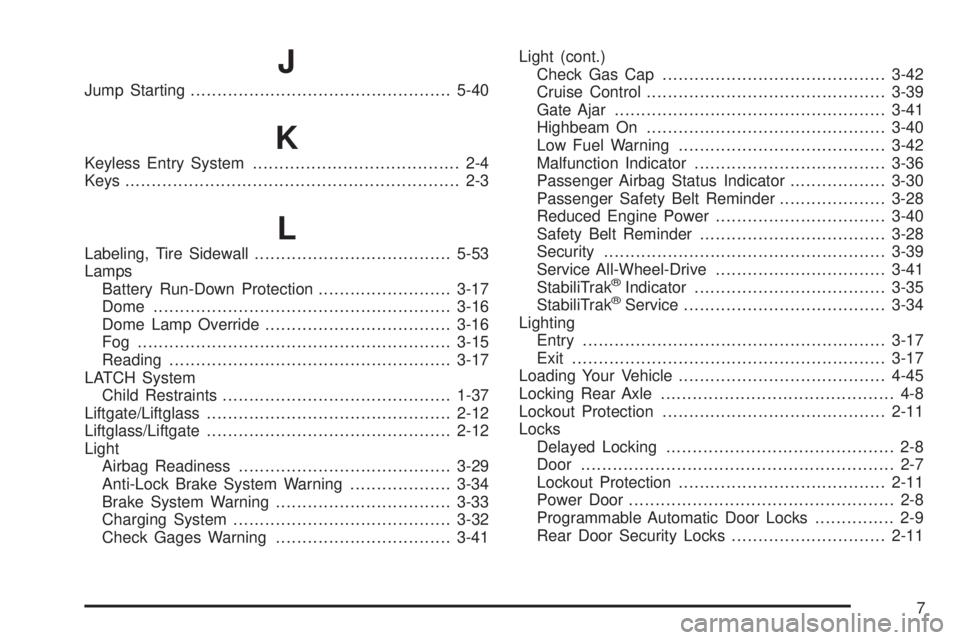
J
Jump Starting.................................................5-40
K
Keyless Entry System....................................... 2-4
Keys............................................................... 2-3
L
Labeling, Tire Sidewall.....................................5-53
Lamps
Battery Run-Down Protection.........................3-17
Dome........................................................3-16
Dome Lamp Override...................................3-16
Fog ...........................................................3-15
Reading.....................................................3-17
LATCH System
Child Restraints...........................................1-37
Liftgate/Liftglass..............................................2-12
Liftglass/Liftgate..............................................2-12
Light
Airbag Readiness........................................3-29
Anti-Lock Brake System Warning...................3-34
Brake System Warning.................................3-33
Charging System.........................................3-32
Check Gages Warning.................................3-41Light (cont.)
Check Gas Cap..........................................3-42
Cruise Control.............................................3-39
Gate Ajar...................................................3-41
Highbeam On.............................................3-40
Low Fuel Warning.......................................3-42
Malfunction Indicator....................................3-36
Passenger Airbag Status Indicator..................3-30
Passenger Safety Belt Reminder....................3-28
Reduced Engine Power................................3-40
Safety Belt Reminder...................................3-28
Security.....................................................3-39
Service All-Wheel-Drive................................3-41
StabiliTrak
®Indicator....................................3-35
StabiliTrak®Service......................................3-34
Lighting
Entry.........................................................3-17
Exit...........................................................3-17
Loading Your Vehicle.......................................4-45
Locking Rear Axle............................................ 4-8
Lockout Protection..........................................2-11
Locks
Delayed Locking........................................... 2-8
Door........................................................... 2-7
Lockout Protection.......................................2-11
Power Door.................................................. 2-8
Programmable Automatic Door Locks............... 2-9
Rear Door Security Locks.............................2-11
7
Page 464 of 470
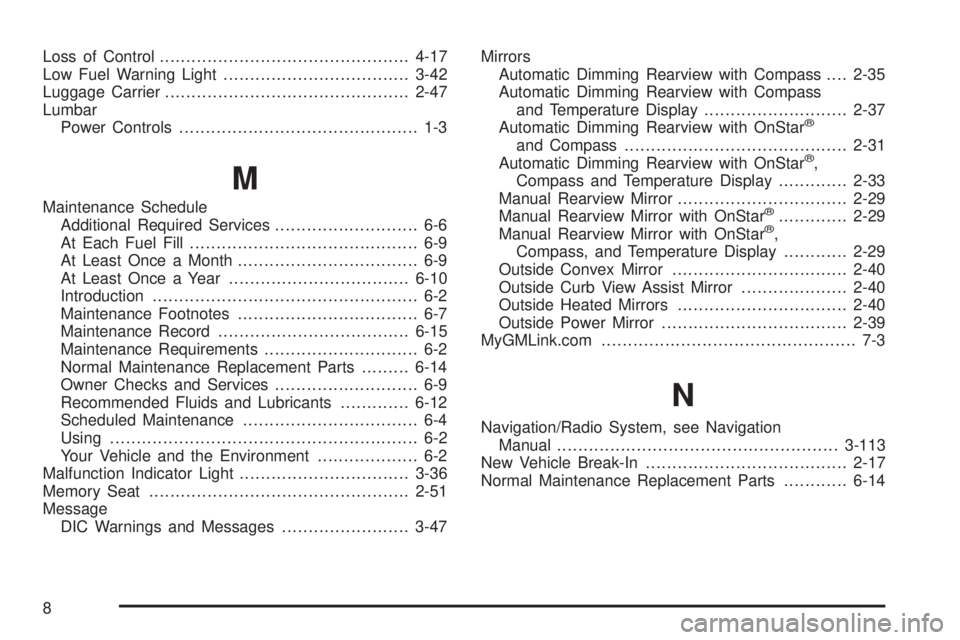
Loss of Control...............................................4-17
Low Fuel Warning Light...................................3-42
Luggage Carrier..............................................2-47
Lumbar
Power Controls............................................. 1-3
M
Maintenance Schedule
Additional Required Services........................... 6-6
At Each Fuel Fill........................................... 6-9
At Least Once a Month.................................. 6-9
At Least Once a Year..................................6-10
Introduction.................................................. 6-2
Maintenance Footnotes.................................. 6-7
Maintenance Record....................................6-15
Maintenance Requirements............................. 6-2
Normal Maintenance Replacement Parts.........6-14
Owner Checks and Services........................... 6-9
Recommended Fluids and Lubricants.............6-12
Scheduled Maintenance................................. 6-4
Using.......................................................... 6-2
Your Vehicle and the Environment................... 6-2
Malfunction Indicator Light................................3-36
Memory Seat.................................................2-51
Message
DIC Warnings and Messages........................3-47Mirrors
Automatic Dimming Rearview with Compass....2-35
Automatic Dimming Rearview with Compass
and Temperature Display...........................2-37
Automatic Dimming Rearview with OnStar
®
and Compass..........................................2-31
Automatic Dimming Rearview with OnStar®,
Compass and Temperature Display.............2-33
Manual Rearview Mirror................................2-29
Manual Rearview Mirror with OnStar
®.............2-29
Manual Rearview Mirror with OnStar®,
Compass, and Temperature Display............2-29
Outside Convex Mirror.................................2-40
Outside Curb View Assist Mirror....................2-40
Outside Heated Mirrors................................2-40
Outside Power Mirror...................................2-39
MyGMLink.com................................................ 7-3
N
Navigation/Radio System, see Navigation
Manual.....................................................3-113
New Vehicle Break-In......................................2-17
Normal Maintenance Replacement Parts............6-14
8
Page 465 of 470
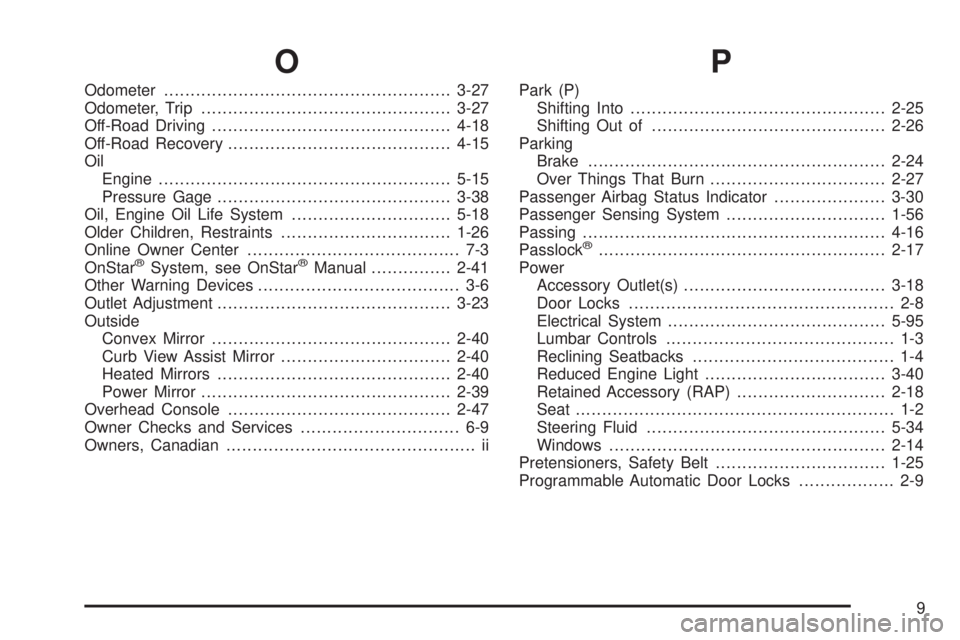
O
Odometer......................................................3-27
Odometer, Trip...............................................3-27
Off-Road Driving.............................................4-18
Off-Road Recovery..........................................4-15
Oil
Engine.......................................................5-15
Pressure Gage............................................3-38
Oil, Engine Oil Life System..............................5-18
Older Children, Restraints................................1-26
Online Owner Center........................................ 7-3
OnStar
®System, see OnStar®Manual...............2-41
Other Warning Devices...................................... 3-6
Outlet Adjustment............................................3-23
Outside
Convex Mirror.............................................2-40
Curb View Assist Mirror................................2-40
Heated Mirrors............................................2-40
Power Mirror...............................................2-39
Overhead Console..........................................2-47
Owner Checks and Services.............................. 6-9
Owners, Canadian............................................... ii
P
Park (P)
Shifting Into................................................2-25
Shifting Out of............................................2-26
Parking
Brake........................................................2-24
Over Things That Burn.................................2-27
Passenger Airbag Status Indicator.....................3-30
Passenger Sensing System..............................1-56
Passing.........................................................4-16
Passlock
®......................................................2-17
Power
Accessory Outlet(s)......................................3-18
Door Locks.................................................. 2-8
Electrical System.........................................5-95
Lumbar Controls........................................... 1-3
Reclining Seatbacks...................................... 1-4
Reduced Engine Light..................................3-40
Retained Accessory (RAP)............................2-18
Seat............................................................ 1-2
Steering Fluid.............................................5-34
Windows....................................................2-14
Pretensioners, Safety Belt................................1-25
Programmable Automatic Door Locks.................. 2-9
9
Page 468 of 470

Service (cont.)
California Proposition 65 Warning.................... 5-4
Doing Your Own Work................................... 5-4
Engine Soon Light.......................................3-36
Publications Ordering Information...................7-14
Servicing Your Airbag-Equipped Vehicle..............1-60
Setting the Time.............................................3-59
Sheet Metal Damage.......................................5-91
Shifting Into Park (P).......................................2-25
Shifting Out of Park (P)...................................2-26
Signals, Turn and Lane-Change.......................... 3-7
Spare Tire.....................................................5-85
Accessory In�ator........................................5-68
Installing....................................................5-74
Removing...................................................5-72
Storing.......................................................5-82
Speci�cations, Capacities...............................5-105
Speedometer..................................................3-27
StabiliTrak
®System.......................................... 4-9
StabiliTrak®Indicator Light................................3-35
StabiliTrak®Service Light.................................3-34
Starting Your Engine.......................................2-19
Steering........................................................4-13
Steering Wheel Controls, Audio.......................3-126
Steering Wheel, Tilt Wheel................................. 3-6
Storage Areas
Center Console Storage Area........................2-47
Convenience Net.........................................2-49
Glove Box..................................................2-46Storage Areas (cont.)
Luggage Carrier..........................................2-47
Overhead Console.......................................2-47
Rear Floor Storage Lid.................................2-48
Stuck in Sand, Mud, Ice or Snow......................4-44
Sun Visors.....................................................2-15
Sunroof.........................................................2-50
Suspension....................................................4-50
T
Tachometer....................................................3-27
Taillamps
Turn Signal Lamps......................................5-48
Theft-Deterrent, Radio....................................3-126
Theft-Deterrent Systems...................................2-15
Content Theft-Deterrent................................2-15
Passlock
®...................................................2-17
Throttle, Adjustable..........................................2-20
Tilt Wheel........................................................ 3-6
Tires.............................................................5-52
Aluminum Wheels, Cleaning..........................5-90
Buying New Tires........................................5-62
Chains.......................................................5-67
Changing a Flat Tire....................................5-70
Cleaning....................................................5-91
Different Size..............................................5-63
If a Tire Goes Flat.......................................5-69
12